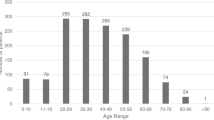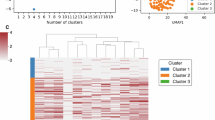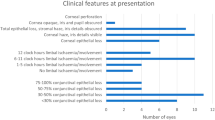Abstract
Background/objectives
To investigate ocular exposures associated with household cleaning products in the United States.
Subjects/methods
A retrospective analysis of ocular exposures associated with household cleaning products was conducted using data from the National Poison Data System from 2000 through 2016.
Results
From January 2000 through December 2016, poison control centres in the United States received 319,508 calls for household cleaning product-related ocular exposures, averaging 18,795 exposures annually. The annual frequency of exposures decreased significantly by 28.8% during the study period. The rate of exposures per 100,000 US residents was 28.4 among young children (<6 years), 4.8 among older children (6–12 years), 4.2 among teenagers (13–19 years), and 4.2 among adults (≥20 years); children 2 years old had the highest rate of exposure (62.8). Bleaches (25.9%), wall/floor/tile cleaners (13.4%), disinfectants (10.8%), laundry detergents (6.1%), and glass cleaners (5.3%) were the non-miscellaneous product subcategories most commonly associated with ocular exposures. The product subcategories associated with the greatest proportion of major medical outcomes were drain cleaners (1.4%), oven cleaners (1.1%), and automatic dishwasher detergents (0.4%).
Conclusions
On average, the United States poison control centres received approximately two reports of household cleaning product-related ocular exposures every hour during the 17-year study period. Although the annual number and rate of exposures declined during this time, the number of these exposures remains high, especially among young children, underscoring the need for additional prevention efforts. Contrary to the overall trend, ocular exposures to laundry detergent packets have increased significantly and merit special preventive action.
Similar content being viewed by others
Login or create a free account to read this content
Gain free access to this article, as well as selected content from this journal and more on nature.com
or
References
American Association of Poison Control Centers. National poison data system annual reports. Alexandria, VA, USA, 2016. http://www.aapcc.org/annual-reports/. Accessed 5 Feb 2018.
Williams H, Moyns E, Bateman DN, Thomas SH, Thompson JP, Allister Vale J. Hazard of household cleaning products: a study undertaken by the UK national poisons information service. Clin Toxicol. 2012;50:770–5.
McKenzie LB, Ahir N, Stolz U, Nelson NG. Household cleaning product-related injuries treated in US emergency departments in 1990–2006. Pediatrics. 2010;126:509–16.
Franklin RL, Rodgers GB. Unintentional child poisonings treated in United States hospital emergency departments: national estimates of incident cases, population-based poisoning rates, and product involvement. Pediatrics. 2008;122:1244–51.
Valdez AL, Casavant MJ, Spiller HA, Chounthirath T, Xiang H, Smith GA. Pediatric exposure to laundry detergent pods. Pediatrics. 2014;134:1127–35.
Huntington S, Heppner J, Vohra R, Mallios R, Geller RJ. Serious adverse effects from single-use detergent sacs: report from a U.S. statewide poison control system. Clin Toxicol. 2014;52:220–5.
American Association of Poison Control Centers. National poison data system (NPDS): NPDS system manual. Alexandria, VA, USA, 2009. http://www.aapcc.org/data-system/. Accessed 5 Feb 2018.
Wolkin AF, Martin CA, Law RK, Schier JG, Bronstein AC. Using poison center data for national public health surveillance for chemical and poison exposure and associated illness. Ann Emerg Med. 2012;59:56–61.
US Census Bureau. Geographic terms and concepts—Census divisions and census regions. Suitland, MD, USA, 2015. https://www2.census.gov/geo/docs/maps-data/maps/reg_div.txt. Accessed 5 Feb 2018.
US Census Bureau. Population and housing unit estimates datasets. Suitland, MD, USA, 2017. https://www.census.gov/programs-surveys/popest/data/data-sets.All.html%0D. Accessed 5 Feb 2018.
Pollard KA, Xiang H, Smith GA. Pediatric eye injuries treated in US emergency departments, 1990–2009. Clin Pediatr (Phila). 2012;51:374–81.
McGwin G Jr., Hall TA, Xie A, Owsley C. Trends in eye injury in the United States, 1992–2001. Investig Ophthalmol Vis Sci. 2006;47:521–7.
Walton WW. An evaluation of the Poison Prevention Packaging Act. Pediatrics. 1982;69:363–70. http://pediatrics.aappublications.org/content/69/3/363.full.pdf%5Cn, http://www.ncbi.nlm.nih.gov/pubmed/7063294.
Centers for Disease Control and Prevention. Developmental Milestones. Atlanta, GA, USA, 2017. https://www.cdc.gov/ncbddd/actearly/milestones/index.html. Accessed 5 Feb 2017.
Bertinelli A, Hamill J, Mahadevan M, Miles F. Serious injuries from dishwasher powder ingestions in small children. J Paediatr Child Health. 2006;42:129–33.
Beirens TMJ, van Beeck EF, Dekker R, Brug J, Raat H. Unsafe storage of poisons in homes with toddlers. Accid Anal Prev. 2006;38:772–6.
Harley EH, Collins MD. Liquid household bleach ingestion in children: a retrospective review. Laryngoscope. 1997;107:122–5.
Ashby K, Routley V. Childhood domestic chemical and plant poisonings. Hazard. 1996;28:1–16.
Patel B, Groom L, Prasad V, Kendrick D. Parental poison prevention practices and their relationship with perceived toxicity: cross-sectional study. Inj Prev. 2008;14:389–95.
Davis MG, Casavant MJ, Spiller HA, Chounthirath T, Smith GA. Pediatric exposures to laundry and dishwasher detergents in the United States: 2013-2014. Pediatrics. 2016;137:5.
Swain TA, McGwin G, Griffin R. Laundry pod and non-pod detergent related emergency department visits occurring in children in the USA. Inj Prev. 2016;22:396–9.
Ducharme J. Here’s how common the tide pod challenge really is. Time. New York City, NY, USA, 2018. http://time.com/5104225/tide-pod-challenge/. Accessed 3 Mar 2018.
Hogg JL. Acid-Base Reactions. In: CHEM2: Chemistry in Your World. 2nd ed. Brooks Cole Cengage Learning: Boston, MA, USA, 2014. p. 167.
Grant WM. Description of toxic substances and their effects on the eyes. In: Charles CT, editor. Toxicology of the Eye. Charles Thomas Publisher Ltd: Springfield, IL, USA, 1962, pp 17–22.
Morgan SJ. Chemical burns of the eye: causes and management. Br J Ophthalmol. 1987;71:854–7.
Singh P, Tyagi M, Kumar Y, Gupta K, Sharma P. Ocular chemical injuries and their management. Oman J Ophthalmol. 2013;6:83–6.
Setlik J, Ho M, Bond GR. Emergency department use after pediatric pharmaceutical ingestion: comparison of two national databases. Clin Toxicol. 2010;48:64–7.
Author information
Authors and Affiliations
Corresponding author
Ethics declarations
Conflict of interest
The authors declare that they have no conflict of interest.
Additional information
Publisher’s note Springer Nature remains neutral with regard to jurisdictional claims in published maps and institutional affiliations.
Rights and permissions
About this article
Cite this article
Kamboj, A., Spiller, H.A., Casavant, M.J. et al. Household cleaning product-related ocular exposures reported to the United States poison control centres. Eye 34, 1631–1639 (2020). https://doi.org/10.1038/s41433-019-0691-9
Received:
Revised:
Accepted:
Published:
Issue Date:
DOI: https://doi.org/10.1038/s41433-019-0691-9
This article is cited by
-
Epidemiology of Consumer-Product-Related Ocular Injuries in the Geriatric Population in the United States
Ophthalmology and Therapy (2024)
-
Nonlinear fourth-order elastic characterization of the cornea using torsional wave elastography
Physical and Engineering Sciences in Medicine (2023)



